
Lighting control console
Encyclopedia
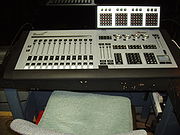
Lighting designer
The role of the lighting designer within theatre is to work with the director, choreographer, set designer, costume designer, and sound designer to create an overall 'look' for the show in response to the text, while keeping in mind issues of visibility, safety and cost...
to control multiple lights
Stage lighting
Modern stage lighting is a flexible tool in the production of theatre, dance, opera and other performance arts. Several different types of stage lighting instruments are used in the pursuit of the various principles or goals of lighting. Stage lighting has grown considerably in recent years...
at once. They are used throughout the entertainment industry and are normally placed at the Front of House
Front of House
Front of house is primarily a theatrical term, referring to the portion of the building that is open to the public. In theatre and live music venues, it typically refers to the auditorium and foyer, as opposed to the stage and backstage areas...
(FOH) position or in a control booth
Control booth (theater)
The control booth, control room, lighting box, technical booth, or just booth to theatre or television technicians is the area designated for the operation of technical equipment , and is sometimes the location of the deputy stage manager's station as well as the lighting controls and sound board...
.
All lighting control consoles can control dimmer
Dimmer
Dimmers are devices used to vary the brightness of a light. By decreasing or increasing the RMS voltage and, hence, the mean power to the lamp, it is possible to vary the intensity of the light output...
s which control the intensity of the lights. Many modern consoles can also control automated lighting
Intelligent lighting
Intelligent lighting refers to stage lighting that has automated or mechanical abilities beyond those of traditional, stationary illumination. Although the most advanced intelligent lights can produce extraordinarily complex effects, the intelligence lies with the programmer of the show rather...
(lights that can move, change colors and gobo patterns
Gobo (lighting)
A gobo derived from "Go Between" or Goes Before Optics -originally used on film sets, is a physical template slotted inside, or placed in front of, a lighting source, used to control the shape of emitted light....
), fog machine
Fog machine
A fog machine or smoke machine is a device which emits a dense vapour that appears similar to fog or smoke. This artificial fog is most commonly used in professional entertainment applications, but smaller, more affordable fog machines are becoming common for personal use. Fog machines can also be...
s and hazers
Haze machine
Haze machines, or haze generators , are effects machines similar to fog machines, designed to produce an unobtrusive, homogeneous clouds suspended in the air intended primarily to make light beams visible or create a subtle diffusion.-Properties:Unlike theatrical fog, which is typically intended to...
, and other special effects devices.
Lighting consoles communicate with the dimmers and other devices in the lighting system via an electronic control protocol
Communications protocol
A communications protocol is a system of digital message formats and rules for exchanging those messages in or between computing systems and in telecommunications...
. The most common protocol used in the entertainment industry today is DMX512, although other protocols (e.g. 0-10 V analog lighting control may still be found in use, and newer protocols such as ACN
Architecture for Control Networks
Architecture for Control Networks is a suite of network protocols for theatrical control being developed by Entertainment Services and Technology Association...
and DMX-512-A are evolving to meet the demands of ever increasing device sophistication.
Types of control consoles
Consoles vary in size and complexity, from small preset boards to dedicated moving light consoles. The purpose of all lighting consoles, however is the same: to consolidate control of the lights into an organized, easy-to-use system, so that the lighting designerLighting designer
The role of the lighting designer within theatre is to work with the director, choreographer, set designer, costume designer, and sound designer to create an overall 'look' for the show in response to the text, while keeping in mind issues of visibility, safety and cost...
can concentrate on producing a good show. Most consoles accept MIDI Show Control
MIDI Show Control
MIDI Show Control, or MSC, is a significant Real Time System Exclusive extension of the international Musical Instrument Digital Interface standard...
signals and commands to allow show control
Show control
Show control is the use of automation technology to link together and operate multiple entertainment control systems in a coordinated manner. It is distinguished from entertainment control , which coordinates elements within a single entertainment discipline such as lighting, sound, video, rigging...
systems to integrate their capabilities into more complex shows.
Preset boards
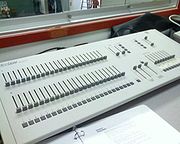
Generally, at least with a preset board, the operator has a cue sheet for each scene, which is a diagram of the board with the faders in their positions as determined by the lighting designer. The operator sets the faders into their positions based on the cue sheets. Typically during a cue, the operator sets the next scene. Then, the operator makes the transition between the scenes using the cross-fader.
Preset boards are not as prevalent since the advent of digital memory consoles, which can store scenes digitally, and are generally much less cumbersome but more expensive than preset boards. However, for small setups such as that of a DJ
Disc jockey
A disc jockey, also known as DJ, is a person who selects and plays recorded music for an audience. Originally, "disc" referred to phonograph records, not the later Compact Discs. Today, the term includes all forms of music playback, no matter the medium.There are several types of disc jockeys...
, they remain the board of choice for their simple to use interface and relative flexibility. Preset boards generally control only conventional lights; though some advanced hybrid consoles can be patched to operate intelligent lights in a round-about way by setting the control channels of the light to channels the preset board can control. This is however not recommended since it is a long, drawn-out, and cumbersome process.
Memory consoles
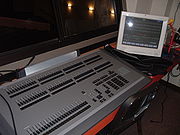
Many memory consoles have a bank of faders. These faders can be programmed to control a single channel (a channel is a lighting designer's numerical name for a dimmer or group of dimmers) or a group of channels (known as a ""submaster"") . The console may also have provision to operate in analog to a manual desk for programming scenes or live control. On some more advanced consoles, faders can be used to control effects, chases (sequences of cues), and moving light effects (if the console can control moving lights).
Moving light controllers
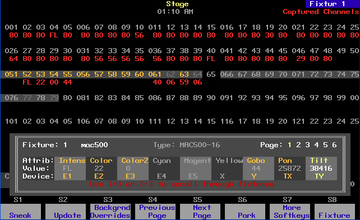
Intelligent lighting
Intelligent lighting refers to stage lighting that has automated or mechanical abilities beyond those of traditional, stationary illumination. Although the most advanced intelligent lights can produce extraordinarily complex effects, the intelligence lies with the programmer of the show rather...
. On midrange controllers, these are usually provided as a section separate from main Preset and Cue stack controls. These include an array of buttons allowing the operator to select the fixture or fixtures they want to control, and a joystick, or a number of wheels or rotary encoder
Rotary encoder
A rotary encoder, also called a shaft encoder, is an electro-mechanical device that converts the angular position or motion of a shaft or axle to an analog or digital code. The output of incremental encoders provides information about the motion of the shaft which is typically further processed...
s to control fixture attributes such as the orientation (pan and tilt), focus, colour, gobos etc. found in this type of light. Unlike a fader that shows its value based on the position of a slider, a wheel is continuously variable and provides no visual feedback for the value of a particular control. Some form of display such as LCD
Liquid crystal display
A liquid crystal display is a flat panel display, electronic visual display, or video display that uses the light modulating properties of liquid crystals . LCs do not emit light directly....
or LED
Light-emitting diode
A light-emitting diode is a semiconductor light source. LEDs are used as indicator lamps in many devices and are increasingly used for other lighting...
is therefore vital for displaying this information. More advanced desks typically have one or more touchscreens, and present a GUI
Graphical user interface
In computing, a graphical user interface is a type of user interface that allows users to interact with electronic devices with images rather than text commands. GUIs can be used in computers, hand-held devices such as MP3 players, portable media players or gaming devices, household appliances and...
that integrates all the aspects of the lighting.
As there is no standard way of controlling an intelligent light, an important function for this type of desk is to consolidate the various ways in which the hundreds of types of intelligent lights are controlled into a single abstract
Abstraction
Abstraction is a process by which higher concepts are derived from the usage and classification of literal concepts, first principles, or other methods....
interface for the user. By integrating knowledge of different fixtures and their attributes into the lighting desk software, the detail of how an attribute such as pan or tilt is controlled for one device vs. another can be hidden from the operator. This frees the operator to think in terms of what they want to achieve (e.g. pan 30 degrees clockwise) instead of how it is achieved for any given fixture (e.g. send value 137 down channel 23). Furthermore, should a lighting fixture need to be replaced with one from a different vendor that has different control sequences, no change need be apparent to the control operator. For some further discussion on how intelligent fixtures are controlled, see Digital Multiplex
Digital Multiplex
DMX512 is a standard for digital communication networks that are commonly used to control stage lighting and effects. It was originally intended as a standardized method for controlling light dimmers, which, prior to DMX512, had employed various incompatible proprietary protocols...
.
Personal computer-based controllers
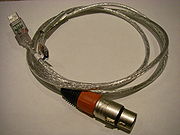
Personal computer
A personal computer is any general-purpose computer whose size, capabilities, and original sales price make it useful for individuals, and which is intended to be operated directly by an end-user with no intervening computer operator...
(PC) based controllers are relatively new, and use software with a feature set similar to that found in a hardware-based console. As dimmers, automated fixtures and other standard lighting devices do not generally have current standard computer interfaces, options such as DMX-512 ports and fader/submaster panels connected via USB
Universal Serial Bus
USB is an industry standard developed in the mid-1990s that defines the cables, connectors and protocols used in a bus for connection, communication and power supply between computers and electronic devices....
are commonplace.
This system allows a "build-to-fit" approach: the end user initially provides a PC that fits their budget and any other needs with future options to improve the system, for example, by increasing the number of DMX outputs or additional console style panels.
Many lightboard vendors offer a PC software version of their consoles. Commercial lighting control software often requires a specific, and possibly expensive, hardware DMX interface. However, inexpensive (<$150) DMX PC interfaces and free or Open source
Open source
The term open source describes practices in production and development that promote access to the end product's source materials. Some consider open source a philosophy, others consider it a pragmatic methodology...
software are available.
Many console vendors also make a software simulator or "offline editor" for their hardware consoles, and these are often downloadable for free. The simulator can be used to pre-program a show, and the cues then loaded into the actual console. In addition, lighting visualization software is available to simulate and approximate how lighting will appear on stage, and this can be useful for programming effects and spotting obvious programming errors such as incorrect colour changes.
Remote focus unit
Many memory consoles have an optional Remote Focus Unit (RFU) controller that can be attached to the light board and used to control the board's functions (though usually in some limited capacity). They are usually small enough to be handheld. This is ideal in situations where moving the light board is impractical, but control is needed away from where the board is; i.e. if the light board is in a control room that is far from the fixtures, such as a catwalk, an RFU can be attached and an electrician or the lighting designer can bring it to a location which is close to the lights. Some of the newer, more advanced boards have RFUs that can be connected through USB or even wirelessly.Various manufacturers offer software for devices such as Android and iPhones that cause the devices to act as remote controllers for their consoles. Also, independent software developers have released applications that can send Art-Net
Art-Net
Art-Net is a proprietary protocol for transmitting the lighting control protocol DMX512-A over the User Datagram Protocol of the TCP/IP suite. The protocol was developed by Wayne Howell and his company, , and is open for implementation with attribution but without charge, and make available a...
packets from an iPhone, thus enabling an iPhone to serve as a fully featured console when used in conjunction with an Art-Net to DMX converter or Art-Net compatible luminaries and dimmers.
See also
- CompuliteCompuliteCompulite is an Israel based company that designs and builds lighting control console, dimmers and other theatre lighting related equipment.The company was founded in 1978 by Dan Redler and Alfred Senator....
- Electronic Theatre ControlsElectronic Theatre ControlsElectronic Theatre Controls is a privately held corporation with global headquarters in Middleton, Wisconsin, United States. An international manufacturer of entertainment and architectural lighting systems, ETC offers professional lighting fixtures, lighting control consoles, dimming equipment...
- Genlyte GroupGenlyte GroupThe Genlyte Group was a company that manufactured and sold lighting fixtures and controls. Products designed by the Genlyte Group include indoor and outdoor fixtures for the commercial, residential, theater, and industrial markets...
- Light board operatorLight board operatorThe light board operator is the electrician who operates the light board. Depending on the scale and type of production, the board op may be responsible for conventional or automated lighting fixtures, as well as practicals and, in some instances, controlling video as well.Sometimes, most commonly...
, the person working the lightboard. - Lighting control systemLighting control systemA lighting control system consists of a device that controls electric lighting and devices, alone or as part of a daylight harvesting system, for a public, commercial, or residential building or property, or the theater...
s for a building or residence. - Strand LightingStrand LightingStrand Lighting is an international theatre and television lighting company founded in 1914 in London's West End that supplies lighting fixtures and controls for the entertainment industry. Strand's products have been used on countless theatre productions and TV shows worldwide.-History:Strand...

